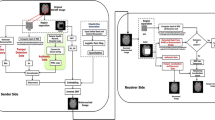Abstract
In this paper, an improved wavelet based medical image watermarking algorithm is proposed. Initially, the proposed technique decomposes the cover medical image into ROI and NROI regions and embedding three different watermarks into the non-region of interest (NROI) part of the transformed DWT cover image for compact and secure medical data transmission in E-health environment. In addition, the method addressing the problem of channel noise distortion may lead to faulty watermark by applying error correcting codes (ECCs) before embedding them into the cover image. Further, the bit error rates (BER) performance of the proposed method is determined for different kind of attacks including ‘Checkmark’ attacks. Experimental results indicate that the Turbo code performs better than BCH (Bose-Chaudhuri-Hochquenghem) error correction code. Furthermore, the experimental results validate the effectiveness of the proposed framework in terms of BER and embedding capacity compared to other state-of-the-art methods. Therefore, the proposed method finds potential application in prevention of patient identity theft in e-health applications.



Similar content being viewed by others
References
O M Al-Qershi and B E Khoo (2010) ROI–based tamper detection and recovery for medical images using reversible watermarking technique, in: IEEE International Conference on Information Theory and Information Security, Beijing pp. 151–155
MH Alwan, M Singh and HF Mahdi (2015) Performance comparison of turbo codes with LDPC codes and with BCH codes for forward error correcting codes, Kuala Lumpur, pp. 556–560
D Bowma (2012) http://www.fiercehealthit.com/story/researchers-use-digital-watermarks-protect- medical-images
Dhanalakshmi R, Thaiyalnayaki K (2010) Dual watermarking scheme with encryption. International Journal of Computer Science and Information Security 7:248–253
Eswaraiah R, Reddy ES (2015) Robust medical image watermarking technique for accurate detection of tampers inside region of interest and recovering original region of interest. IET Image Process 9(8):615–625
A Giakoumaki, K Perakis, A Tagaris, and D Koutsouris (2006) “Digital watermarking in telemedicine applications - towards enhanced data security and accessibility”, proceedings of the 28th IEEE EMBS annual international Conference new York City, USA
Giakoumaki A, Pavlopoulos S, Koutsouris D (2006) Secure and efficient health data management through multiple watermarking on medical images. Medical Biological Engineering & Computing 44:619–631
Hajjaji MA, El-Bay B, Abdelali AB, Mtibaa A (2014) Combining Haar wavelet and Karhunen Loeve transforms for medical images watermarking. Biomed res Int 2014:1–15
Katzenbeisser S, Petitcolas F (2000) Information hiding techniques for steganography and digital watermarking. Artech House, London
B Kumar, SB Kumar and DS Chauhan (2014) Wavelet based imperceptible medical image watermarking using spread-spectrum, 37th International Conference on telecommunications and signal processing, Berlin Germany, 660–664
Kundur D, Hatzinakos D (1999) Digital watermarking for telltale tamper proofing and authentication, proc. IEEE Special Issue on Identification and Protection of Multimedia Information 87(7):1167–1180
J Maˇsek, R Burget, J Karásek, V Uher, S Güney (2013) Evolutionary improved object detector for ultrasound images, 36th International Conference on Telecommunications and Signal processing Rome, Italy, pp. 586–590
MedPix™Medical Image Database available at http://rad.usuhs.mil/medpix/medpix.html
Mohanty SP (2000) Watermarking of digital images. M.S. thesis, Indian Institute of Science, India
Muhammad K, Sajjad M, Mehmood I, Rho S, Baik SW (2016) A novel magic LSB substitution method (M-LSB-SM) using multi-level encryption and achromatic component of an image. Multimed Tools Appl 75(22):14867–14893
Muhammad K, Ahmad J, Rehman NU, Jan Z, Sajjad M (2017) CISSKA-LSB: color image steganography using stego key-directed adaptive LSB substitution method. Multimed Tools Appl 76(6):8597–8626
M Ollove (2014) www.usatoday.com/story/.../stateline-identity- thefts-medical.../5279351
Pandey R, Singh AK, Kumar B, Mohan A (2016) Iris based secure NROI multiple eye image watermarking for Teleophthalmology. Multimed Tools Appl 75(22):14381–14397
A Pavelin, I Klapan, M Kovač, M Katić, R Stevanović, M Rakić and N Klapan, (2006) “A Functional Telemedicine Environment in the Framework of the Croatian Healthcare Information System”, 79–93, Volume 372: Remote Cardiology Consultations Using Advanced Medical Technology, ios press
Rocek A, Slavicek K, Dostal O, Javornik M (2016) A new approach to fully-reversible watermarking in medical imaging with breakthrough visibility. Biomedical Signal Processing and Control 29:44–52
Sajjad M, Muhammad K, Baik SW, Rho S, Jan Z, Yeo SS, Mehmood I (2016) Mobile-cloud assisted framework for selective encryption of medical images with steganography for resource-constrained devices. Multimed Tools Appl 76(3):3519–3536
Singh AK, Dave M, Mohan A (2014) Wavelet based image watermarking: futuristic concepts in information security. Proceedings of the National Academy of Sciences, India Section A: Physical Sciences 84(3):345–359
Singh AK, Dave M, Mohan A (2015) Hybrid technique for robust and imperceptible multiple watermarking using medical images. Multimed Tools Appl 75(14):8381–8401
Singh AK, Kumar B, Dave M and Mohan A (2015) Robust and imperceptible spread-Spectrum watermarking for telemedicine applications, proc. Natl. Acad. Sci., India, Sect a Phys Sci 85(2):295–301.
Singh AK, Dave M, Mohan A (2015) Multilevel encrypted text watermarking on medical images using spread-Spectrum in DWT domain. Wireless Personal Communications, 83(3):2133–2150
AK Singh, B Kumar, M Dave, SP Ghrera and Anand Mohan (2016) Digital image watermarking: techniques and emerging applications, handbook of research on modern cryptographic solutions for Computer and cyber security, IGI global, USA, pp. 246–272
N Terzija, M Repges, K Luck and W Geisselhardt (2002) Digital image watermarking using discrete wavelet transform: performance comparison of error correction codes, In: Proceedings of International Association of Science and Technology for Development (IASTED), pp. 1-5
Author information
Authors and Affiliations
Corresponding author
Rights and permissions
About this article
Cite this article
Chauhan, D.S., Singh, A.K., Kumar, B. et al. Quantization based multiple medical information watermarking for secure e-health. Multimed Tools Appl 78, 3911–3923 (2019). https://doi.org/10.1007/s11042-017-4886-4
Received:
Revised:
Accepted:
Published:
Issue Date:
DOI: https://doi.org/10.1007/s11042-017-4886-4




